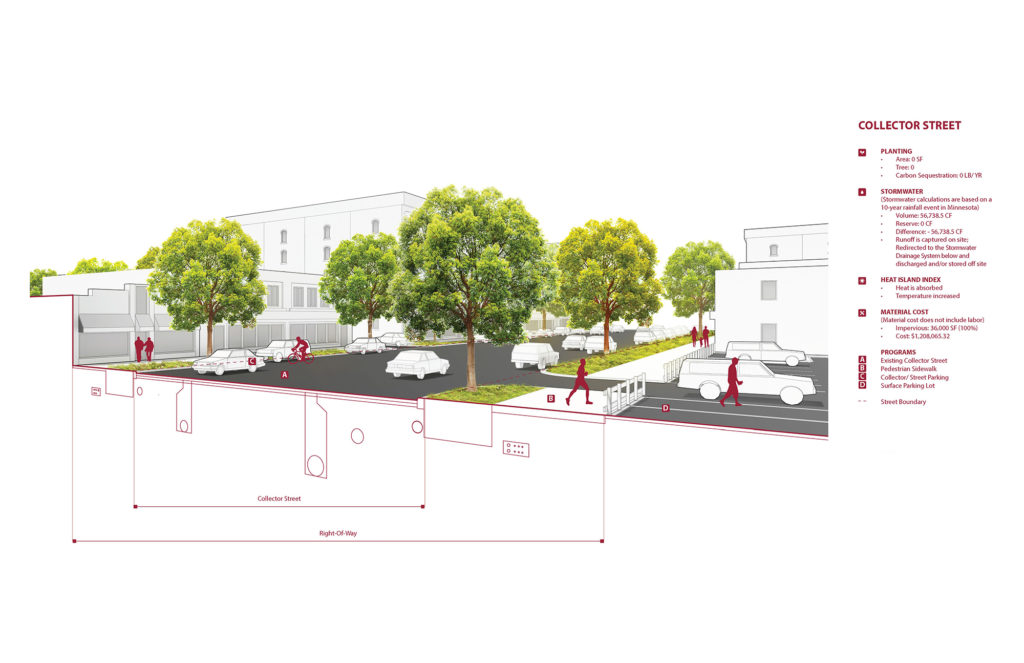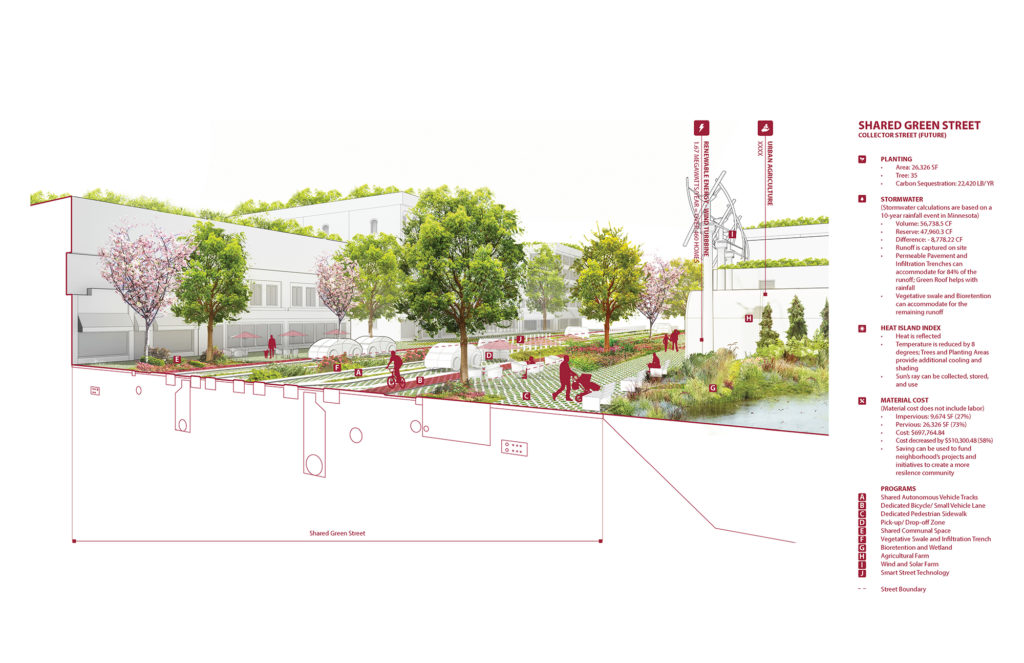When Tom Fisher, a professor in the University of Minnesota’s College of Design, looks to the future of roadways, he sees a dramatically different streetscape than the one most people drive on today. For one thing, the people won’t be doing the driving.
Instead, Fisher, who also is the director of the university’s Minnesota Design Center, sees a future in which autonomous vehicles first briefly share the roads with human-driven vehicles and then inevitably replace those traditional cars and trucks entirely. As a result of that self-driving scenario, the road itself will also change, Fisher says. That’s because AVs are, simply put, better drivers — or at least more precise drivers.
When humans drive cars and trucks, they tend to “wander across the road surface,” shifting a little to the right or left within their lane as they travel along, Fisher says. But AVs, guided by GPS and other navigational aids, follow and maintain a much more precise path, meaning that each AV will drive over the same parts of road surfaces on every trip.
Unfortunately, such precision can lead to repetitive wear damage to a road surface, especially on gravel and asphalt roads, Fisher notes. This was evident in a 2018 pilot project conducted by the Minnesota Department of Transportation using an autonomous bus that left visible ruts in the roads it drove on, caused by the repetitive wheel path tracks of the bus as it followed a programmed route, Fisher explains.
A multidisciplinary team at the University of Minnesota — including the Minnesota Design Center, the College of Science and Engineering, and the School of Public Affairs — is researching how shared AVs will affect community health, equity, livability, and prosperity. This research is being funded by a three-year, $1.75 million grant from the National Science Foundation as part of the NSF’s Smart & Connected Communities grant program.
Reviewing the results from the MnDOT autonomous bus pilot study, Fisher and his colleagues “began to ask ourselves: What would a road be like that could handle the repetitive wear of (autonomous) vehicles?” Their conclusion: AVs will require a different type of street, Fisher says, perhaps one that features tracks of reinforced-concrete grade beams for the AVs to drive along. There would also be connections to adjoining tracks on the side of the road in case a vehicle needs to pull off to pick up or drop off passengers or allow other vehicles to pass.
The use of such grade beams would, in turn, enable the road surface between and around the beams to become pervious. For example, instead of constructing continuously paved roads with curb-and-gutter storm sewer systems — which are necessary today — the future streets for AVs could replace impervious asphalt with permeable concrete pavers or low ground-cover vegetation, such as sedum. Then, by replacing the existing stormwater system with underground stormwater retention basins or adjacent bioswales, “it would allow us to capture and not only retain stormwater but also recharge aquifers” as the water percolates down through the roadbed, Fisher says.
For a 36,000 sq ft road surface, which today is entirely impervious, the new AV street design could feature as much as 27,000 sq ft of permeable surfaces, with only about 9,000 sq ft of impervious concrete for the grade beams, Fisher adds.
Additional benefits would derive from the fact that AVs are expected to generate much greater throughput, which means “you won’t need as many lanes to move to the same number of people,” Fisher notes. Thus, four-lane roads today could need just two lanes in the future, and those lanes could be narrower— perhaps just 8 ft wide lanes compared with the 11 or 12 ft lane widths of current streets, Fisher says. The space no longer needed for road surfaces could then be reallocated to more green space, including trees and other plantings, that could dramatically help with carbon sequestration and reduce the urban heat island effect created by today’s roads.
Even overhead streetlights could disappear, reducing the effects of light pollution in cities and suburbs, since the roadway itself would no longer need to be illuminated. Instead, bollards along the road could simply illuminate the adjoining sidewalk and bike paths.
If, as Fisher expects, AVs are eventually shared rather than individually owned — as part of mobility-as-a-service operations — then many existing parking areas could be converted to other uses as well. As much as 30% of urban and suburban land is currently dedicated to parking, Fisher notes, so all that land could be freed up for alternative uses.
Although AVs will need to share the road with human-driven vehicles for a certain period, Fisher expects that driving itself will eventually be banned in urban and suburban areas and relegated only to the countryside. He compares this scenario to what happened about 100 years ago when cars and trucks began to replace horses.
“We discovered that having horses and cars on the road at the same time doesn’t work very well,” Fisher notes. So today, “we relegate horses to the countryside, and you can’t ride a horse down a city or suburban street. In the same way, within a couple decades, you won’t be able to drive down a city or suburban street.”
As driving a car yourself becomes less common it will also become far more expensive because of the rising cost of car insurance as the insurable pool of high-risk drivers shrinks, Fisher predicts. Eventually, driving could become a hobby just for rich people — and even they will likely need to take AVs to get out to places in the country where they will store their cars, he adds.
The possibilities presented by AVs and the redesign of roads provide “a huge opportunity for our civil engineering community to envision a different kind of infrastructure that is more environmentally friendly and much safer,” Fisher says.
Moving forward, Fisher and his colleagues are working with MnDOT to develop a pilot project to test their proposed redesign of roads for AVs at various sites within the state, including Grand Rapids and Rochester.
An online publication called Future Streets, summarizing the findings and proposals, is expected to be released later this year.






Some interesting things not mentioned about sustainability of this proposal is the backlash from society and most importantly the work unions. If semi trucks go autonomous that puts all the truck drivers out on unemployment. In addition, other jobs such as taxi drivers and delivery drivers will also have some backlash. It also would seem like a hassle to have to store your private car in a storage, and take an AV to the storage just to make a trip where AV’s are not permitted. I think the positives listed in this research are great and needed, however the policies would need to be refined and I imagine will take a long time to perfect or even get approved in the first place. There is still a lot of unknown about AV and how it will fit in urban cities to provide sustainability.
Hullo Mr. Reid
Good Info. Can We have AV hover over pavement about only a foot, so it does not do severe damage to pavement. Really why in world anybody want to own vehicle, Rich people can rent luxury AV. AV need to be keep
clean due to pandemic. I love it no hassle parking, no driveway or garage needed. Question is many people jobs will disappear. People can drive car for fun in country side as some people ride horses in country side.
I am 84 years old. My grandchildren will enjoy the future.
Please do give feedback if you have time. By the way I am Structural Engineer
With a decrease in oil production we will see less asphalt available. Moving to using concrete pavers or plastics will occur. Electrically elevated autos, will allow greenery to grow around the paver blocks. Sensors instead of eye contact will allow more green trees, and more attractive design opportunities. Bicycles and pedestrians can be safely separated by using “cut-off’ devices which are triggered at the sign of danger. Also with flying taxi drones, and flying cars coming to us in a few years, the way autos use pathways will change. Use-of-road patterns will need to be altered as will parking patterns and systems. Fly your car into the multi story parking structure which has a tram to scoot you to the CostCo shopping floor. No more acres of asphalt parking lots…..less land used in urban sprawl. The lane constraints for flying cars will create a whole new challenge to keep cars safely separated, both horizontally and vertically. Many of Disney’s Epcot concepts will be applied to cities. These design challenges are going to be fun !
Why couldn’t truck & bus AVs be programmed so that every third vehicle produced would either travel one foot right of the GPS path, on path, or one foot left of the path? That way the load is spread somewhat but not as much as now.